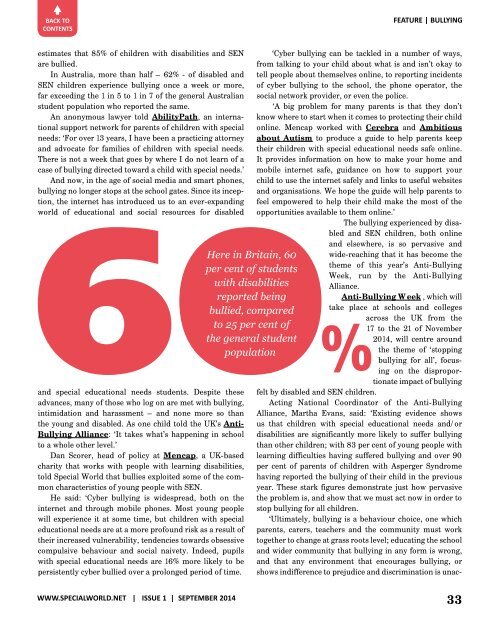special-world-issue-1
special-world-issue-1
special-world-issue-1
- No tags were found...
Create successful ePaper yourself
Turn your PDF publications into a flip-book with our unique Google optimized e-Paper software.
BACK TOCONTENTSFEATURE | BULLYINGestimates that 85% of children with disabilities and SENare bullied.In Australia, more than half – 62% - of disabled andSEN children experience bullying once a week or more,far exceeding the 1 in 5 to 1 in 7 of the general Australianstudent population who reported the same.An anonymous lawyer told AbilityPath, an internationalsupport network for parents of children with <strong>special</strong>needs: ‘For over 13 years, I have been a practicing attorneyand advocate for families of children with <strong>special</strong> needs.There is not a week that goes by where I do not learn of acase of bullying directed toward a child with <strong>special</strong> needs.’And now, in the age of social media and smart phones,bullying no longer stops at the school gates. Since its inception,the internet has introduced us to an ever-expanding<strong>world</strong> of educational and social resources for disabledand <strong>special</strong> educational needs students. Despite theseadvances, many of those who log on are met with bullying,intimidation and harassment – and none more so thanthe young and disabled. As one child told the UK’s Anti-Bullying Alliance: ‘It takes what’s happening in schoolto a whole other level.’Dan Scorer, head of policy at Mencap, a UK-basedcharity that works with people with learning disabilities,told Special World that bullies exploited some of the commoncharacteristics of young people with SEN.He said: ‘Cyber bullying is widespread, both on theinternet and through mobile phones. Most young peoplewill experience it at some time, but children with <strong>special</strong>educational needs are at a more profound risk as a result oftheir increased vulnerability, tendencies towards obsessivecompulsive behaviour and social naivety. Indeed, pupilswith <strong>special</strong> educational needs are 16% more likely to bepersistently cyber bullied over a prolonged period of time.WWW.SPECIALWORLD.NET | ISSUE 1 | SEPTEMBER 2014‘Cyber bullying can be tackled in a number of ways,from talking to your child about what is and isn’t okay totell people about themselves online, to reporting incidentsof cyber bullying to the school, the phone operator, thesocial network provider, or even the police.‘A big problem for many parents is that they don’tknow where to start when it comes to protecting their childonline. Mencap worked with Cerebra and Ambitiousabout Autism to produce a guide to help parents keeptheir children with <strong>special</strong> educational needs safe online.It provides information on how to make your home andmobile internet safe, guidance on how to support yourchild to use the internet safely and links to useful websitesand organisations. We hope the guide will help parents tofeel empowered to help their child make the most of theopportunities available to them online.’The bullying experienced by disabledand SEN children, both onlineand elsewhere, is so pervasive andwide-reaching that it has become thetheme of this year’s Anti-BullyingWeek, run by the Anti-BullyingAlliance.Anti-Bullying Week , which willtake place at schools and collegesacross the UK from the17 to the 21 of November2014, will centre aroundthe theme of ‘stoppingbullying for all’, focusingon the disproportionateimpact of bullyingfelt by disabled and SEN children.Acting National Coordinator of the Anti-BullyingAlliance, Martha Evans, said: ‘Existing evidence showsus that children with <strong>special</strong> educational needs and/ordisabilities are significantly more likely to suffer bullyingthan other children; with 83 per cent of young people withlearning difficulties having suffered bullying and over 90per cent of parents of children with Asperger Syndromehaving reported the bullying of their child in the previousyear. These stark figures demonstrate just how pervasivethe problem is, and show that we must act now in order tostop bullying for all children.‘Ultimately, bullying is a behaviour choice, one whichparents, carers, teachers and the community must worktogether to change at grass roots level; educating the schooland wider community that bullying in any form is wrong,and that any environment that encourages bullying, orshows indifference to prejudice and discrimination is unac-33


